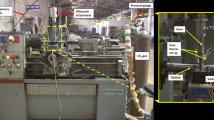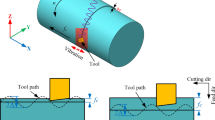Abstract
Titanium alloys are widely employed in aerospace, marine and biomedical industries due to their durability and ability to sustain elevated operating temperature. Vibration assisted turning (VAT) is found to be an effective alternative to machine hard materials and promises significant process improvements compared to conventional turning (CT). This paper presents experimental studies and finite element simulations in turning of Ti6Al4V alloy with uncoated carbide tools. The influence of VAT on residual stress is evaluated in both experiment and simulation. The residual stresses are evaluated experimentally along the direction of cutting and perpendicular to the direction of cutting using X-ray diffraction analysis. 3-D finite element model is developed to predict cutting forces, temperature, and machining-induced stress field and the residual stresses. It is observed that the nature of residual stresses is predominantly compressive in VAT compared to CT, due to the reduced the cutting forces, effective stresses, and temperature.












Similar content being viewed by others
References
Boyer, R. R. (1996). An overview on the use of titanium in the aerospace industry. Materials Science and Engineering A, 213(1), 103–114.
Polini, W., & Turchetta, S. (2014). Cutting force, tool life and surface integrity in milling of titanium alloy Ti–6Al–4V with coated carbide tools. Proceedings of the Institution of Mechanical Engineers Part B: Journal of Engineering Manufacture, 230(4), 694–700.
Su, J.-C. (2006). Residual stress modeling in machining processes. Ph.D. thesis, George W. Woodruff School of Mechanical Engineering, Georgia Institute of Technology.
Dahlman, P., Gunnberg, F., & Jacobson, M. (2004). The influence of rake angle, cutting feed and cutting depth on residual stresses in hard turning. Journal of Materials Processing Technology, 147, 181–184.
Thiele, J. D., & Melkote, S. N. (2000). Effect of cutting-edge geometry and workpiece hardness on surface residual stresses in finish hard turning of AISI 52100 steel. Journal of Manufacturing Science and Engineering, 122, 642–649.
Maurotto, A., Muhammad, R., Roy, A., Babitsky, V. I., & Silberschmidt, V. V. (2012). Comparing machinability of Ti-15-3-3-3 and Ni-625 alloys in UAT. Procedia CIRP, 1, 330–335.
Kumar, M. N., Kanmani Subbu, S., Vamsi Krishna, P., & Venugopal, A. (2014). Vibration assisted conventional and advanced machining: A review. Procedia Engineering, 97, 1577–1586.
Brehl, D. E., & Dow, T. A. (2008). Review of vibration-assisted machining. Precision Engineering, 32, 153–172.
Babitskya, V. I., Kalashnikov, A. N., Meadows, A., & Wijesundara, A. A. H. P. (2003). Ultrasonically assisted turning of aviation materials. Journal of Materials Processing Technology, 132, 157–167.
Ding, H., Ibrahim, R., Cheng, K., & Chen, S.-J. (2010). Experimental study on machinability improvement of hardened tool steel using two-dimensional vibration-assisted micro-end-milling. International Journal of Machine Tools and Manufacture, 50(12), 1115–1118.
Mitrofanov, A. V., Babitsky, V. I., & Silberschmidt, V. V. (2003). Finite element simulations of ultrasonically assisted turning. Computational Materials Science, 28, 645–653.
Muhammad, R., Hussain, M. S., Maurotto, A., Siemers, C., Roy, A., & Silberschmidt, V. V. (2014). Analysis of a free-machining α + β titanium alloy using conventional and ultrasonically assisted turning. Journal of Materials Processing Technology, 214, 906–915.
Sharma, V., & Pandey, P. M. (2016). Optimization of machining and vibration parameters for residual stresses minimization in ultrasonic assisted turning of 4340 hardened steel. Ultrasonics, 70, 172–182.
Ahmed, N., Mitrofanov, A. V., Babitsky, V. I., & Silberschmidt, V. V. (2006). Analysis of material response to ultrasonic vibration loading in turning Inconel 718. Materials Science and Engineering: A, 424(1–2), 318–325.
ABAQUS. (2011). Standard user’s manual. Version 6.10.
Johnson, G. R., & Cook, W. H. (1985). Fracture characteristics of three metals subjected to various strains, strain rates, temperatures and pressures. Engineering Fracture Mechanics, 21, 31–48.
Johnson, G. R., & Cook, W. H. (1983, April). A constitutive model and data for metals subjected to large strains, high strain rates, and high temperatures. In Proceedings of 7th international symposium on ballistics, Hague, Netherlands.
Lee, W.-S., & Lin, C.-F. (1998). Plastic deformation and fracture behaviour of Ti–6Al–4V alloy loaded with high strain rate under various temperatures. Materials Science and Engineering A, 241(1), 48–59.
Maroju, N. K., Vamsi, K. P., & Jin, X. (2017). Investigations on feasibility of low-frequency vibration-assisted turning. International Journal of Advanced Manufacturing Technology, 91(9), 3775–3788.
Altintas, Y. (2000). Manufacturing automation: Metal cutting mechanics, machine tool vibrations, and CNC design. Cambridge: Cambridge University Press.
He, B. B., Preckwinkel, U., & Smith, K. L. (1999). Fundamentals of two-dimensional X-ray diffraction (XRD2). Advances in X-Ray Analysis, 43(1), 273–280.
He, B. B. (2003). Introduction to two-dimensional X-ray diffraction. Powder Diffraction, 18(2), 71–85.
Miyazaki, T., & Sasaki, T. (2016). A comparison of X-ray stress measurement methods based on the fundamental equation. Journal of Applied Crystallography, 49(2), 426–432.
Maroju, N. K., Krishna, P. V., & Jin, X. (2017). Assessment of high and low frequency vibration assisted turning with material hardness. International Journal of Machining and Machinability of Materials, 19(2), 110–135.
Maroju, N. K., & Jin, X. (2017). Effects of vibration assistance on surface residual stress in grinding of Ti6Al4V alloy. Procedia Manufacturing, 10, 171–182.
Author information
Authors and Affiliations
Corresponding author
Rights and permissions
About this article
Cite this article
Maroju, N.K., Pasam, V.K. FE Modeling and Experimental Analysis of Residual Stresses in Vibration Assisted Turning of Ti6Al4V. Int. J. Precis. Eng. Manuf. 20, 417–425 (2019). https://doi.org/10.1007/s12541-019-00021-3
Received:
Revised:
Accepted:
Published:
Issue Date:
DOI: https://doi.org/10.1007/s12541-019-00021-3




